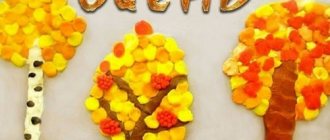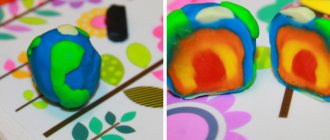Match tournament
This game program for children consists of fun relay races and simple speed tasks. Children of any age and in any number can participate. Both individual and team championships are possible.
For the tournament you will need matchboxes with matches.
The player or team that completes the task first is awarded 3 points, the second - 2, and the third - 1. The winner of the competition is the player or team with the most points based on the results of all competitions.
You can keep score using potatoes, sticking matches into them according to the number of points scored in the competition. At the end of the game program, all that remains is to count the number of matches in the potatoes of each team.
Match tournament rules
- The relay can be considered completed only when the participant who started last in the team delivers the box to the place where the movement started.
- The participant must stop if the box falls while moving, pick it up and put it in its original place, only after that can he continue on his way.
- For match construction tasks, participants should be given a certain amount of time. But you can post phrases based on the principle of who is faster.
Tasks for the match tournament
- Use the matches to write the phrase “Matches are not a toy for children!”
- Place the matchbox on the top of your head and walk along the given route.
- Place the matchbox on your shoulders and walk with such “epaulets” along the given route.
- Walk along the given route, placing the narrow side of the box on your clenched fist.
- For each team, 5 boxes of matches are scattered in different places. The task: collect them faster than your opponents.
- In two minutes, build the highest possible “well” from matches.
- Walk along the given route, placing the boxes in the lumbar area.
- Walk along the given route, placing one matchbox on the soles of your feet in the area of the insteps.
- Walk along the given route, holding the box between your chin and neck.
- The participant, having put the outer part of the box on his nose, must pass it to his teammate without using his hands (from nose to nose), who then passes it to the next one, etc.
- Hook the inner parts of the matchboxes on your ears and walk with them along the given route.
- Make a train with two carriages out of matches.
- Place the matchbox on the edge of the table and blow on it, pushing it forward until it falls on the opposite side.
- Make the word “Winner!” from the matches.
We hope that the game programs we offer will help you organize a real summer holiday for children.
Non-traditional Olympic Games
Every four years, people around the globe watch in fascination as athletes from different countries try to run faster, throw further and jump higher than everyone else. Offer children's camp participants to test themselves as well.
Any sports competition always captivates children, because they like to compete and measure their strength and dexterity. The Olympic Games in the camp are a traditional event, but we propose to introduce elements of unusualness into these sports competitions. Funny competitions that give everyone the opportunity to express themselves - isn’t this the kind of entertainment that’s best suited for children in the summer? But we suggest starting this event for children with the opening ceremony.
Olympic Games Opening Ceremony
The logo of the Olympic Games is known all over the world - these are five intertwined rings. The motto of the Olympics is also well known: “Faster, higher, stronger.” During the opening ceremony, participants from each country carry their flags.
Teach children about the history of the Olympic Games, the significance of the opening ceremony, and encourage each squad to create their own flags and mottos. Flags can be drawn on durable paper, such as cardboard, and the motto can be part of the flag's design. Once the flags are ready, the opening ceremony of the Olympics can begin, at which children should be invited to make a presentation of their team and explain the meaning of their flag.
After the opening ceremony is over, you can move on to the competition part.
Unusual “Olympic” competitions for children in the summer
For each of the proposed types of competitions, preliminary preparation will be required (attributes, markings, places for fans).
- "Discus thrower". Distance throwing competition. You can use old CDs for the competition. Each participant has 3 attempts. The longest throw is counted.
- "Javelin Throwers" Prepare a simple target (draw with chalk on a wall or paint on a cardboard box) and blow up several long, thin balloons. The goal is to hit the target with the spear ball. You can also throw these balls at a distance.
- "5 rings" You will need 5 rings, painted in Olympic colors. You can cut them out of regular cardboard or disposable plates. Also prepare 5 wooden sticks that need to be driven into the ground. Children will have to throw rings from a distance of 4-5 steps. The most accurate participant wins.
- "Weightlifters." Give soft plastic balls or tennis balls "weight" by writing numbers from 5 to infinity on them. Then they need to be placed in a large box. The goal of the competition is to hold as many balls as possible in your hands, choosing those with the highest “value.” The weightlifter who manages to hold the “most weight” is declared the winner.
- " Box ." The boxing ring is designated, and the presenter invites the boxers to fight. He sets them up for a serious boxing match and suggests putting on gloves (you can take work gloves). When the opponents are ready and waiting for the command to start the battle, the host suddenly announces that the word “box” is translated from English as “box” and changes the task for the players: they must throw boxes of different sizes at a distance. The strongest is the one whose “box” flies the farthest.
- "Mopbrokerling". Markings are made as in curling (a long rectangular area, two houses - targets). Curling brushes are mops, stones are small toy cars. The rules of the game should be simplified: an accurate throw (driving and stopping the car at the target house) gives a point.
- " Show jumping " . Prepare an obstacle course and give the contestant a stick, which will be his horse. Having ridden it, he will have to overcome an obstacle course. Obstacles should not be too high, make them accessible to overcome “on horseback”. Victory will go to the most dexterous and fastest rider.
Game program for kindergarten
A program for correcting communication abilities in children of senior preschool age through play activities aimed at developing cooperation “You are my friend and I am your friend.”
Authors: Nikulina Tatyana Nikolaevna, teacher.
Place of work: MKDOU No. 31, Ushaki village, Tosnensky district, Leningrad region; Gavrilova Lyubov Aleksandrovna, teacher. Place of work: MBDOU “Kindergarten No. 26”, Nazia village, Kirov district, Leningrad region. “A child’s ability to communicate positively allows him to live comfortably in the company of people...” Vygotsky L. S.
Explanatory note
It's no secret that a person becomes a person as a result of communicating with other people. Everyone has a certain level of communication abilities, that is, individual personality characteristics. Preschool age is an important period in the development of a child’s personality, including his communicative development. During this period, when children especially need to receive information, a special organization of communication is needed that will help the child acquire communicative competence that helps to communicate effectively. Communicative competence is manifested in the child’s free expression of his desires and intentions using verbal and non-verbal means. Communicative competence is determined by whether a child knows how to make contact with a stranger, understand his personal qualities and intentions, anticipate the results of his behavior and build his behavior in accordance with this. Children aged five to six years, provided a favorable social environment is created, can freely communicate with others, observing the norms and rules accepted in society. However, currently there are serious difficulties for children in communicating, especially with peers. This is expressed in direct aggression (pugnacity), reluctance to communicate, conflict, whims, touchiness, shyness, which leads to difficulties in establishing friendly relationships and the ability to communicate constructively. All these problems are due to the fact that serious changes have occurred in the life of society, and most importantly, in the family. The number of children who are without close contact with their parents is constantly growing, as family traditions are disappearing, parents either simply do not have enough time, and most often, the desire to communicate with their children. All this creates serious difficulties for the development of communication abilities and the development of the child as a whole. Thus, teachers are faced with the task of creating conditions conducive to organizing an emotionally favorable atmosphere in the group and developing in children a sense of self-confidence. The most effective way to develop communicative qualities, a positive attitude towards other people, constructive interaction and cooperation with peers and adults is play. Thanks to the play method, children have the opportunity to express their experiences and show their creativity. Also, the gaming technique allows preschool children to easily and quickly switch from one type of activity to another. By creating a favorable psychological atmosphere in the group, the teacher will never have problems with the discipline of his students. When creating this program, we wanted to pay special attention to games to develop cooperation in children of senior preschool age, as one of the most important communicative qualities that a child needs to master by senior preschool age.
Purpose of the program:
Correction and development of the communicative sphere in children of senior preschool age through games to develop cooperation.
Tasks:
1. Develop collaboration skills. 2. Form friendly relationships between children. 3.Develop social behavior skills. 4.Form a sense of belonging to the group. 5.Develop the child’s ability to express his emotions. 6. Help the child experience a certain emotional state, give it a verbal designation. 7. Contribute to the elimination of undesirable character traits and behavior of children of senior preschool age. 8. Introduce children to the culture of their people and expand their understanding of the life of people in other countries.
Guidelines:
This methodological development will help teachers systematically and consistently use the proposed material to develop communicative abilities in children of senior preschool age. The activity is developmental in nature and takes place in a playful way. Communicative games for cooperation can be included in routine processes, used during play activities in a group or on a walk, and in organizing leisure activities. This card index includes folk games, which helps to familiarize children with the culture of the peoples of the world, their traditions and the formation of positive communication. Below is a list of games.
Card index of correctional and educational games for the development of cooperation for older preschoolers.
"HELLO, FRIEND"
Purpose of the game: to develop endurance and cooperation skills. Additional goals: developing friendly relationships between children; development of auditory attention; ability to distinguish parts of one's own body. How to play: Children stand in a circle. 1. Hello, my friend, hello, my friend! Let's stand together in a circle. Let's walk in a circle with you, Let's start saying hello together! - Hello, hello, hands! - Hop, hop! - Hello, hello, legs! - Top, top! - Hello, our palms! - Clap clap! - Hello, our knees! - Slap-slap! They wave greetings first with one hand, then with the other. Holding hands, they walk in a circle. They stretch their arms forward. They clap. First one leg is placed on the heel, then the other. They stomp. Turn your palms. "Plates." Stroke your knees with your palms. They slap their palms on their knees. 2. Hello, my friend, hello, my friend! Our friendly circle will gallop! Light legs run in circles, They don’t let us stand still at all. - Hello, round cheeks! - Pooh, pooh! - Hello, marigolds! -Knock, knock! - Hello, my funny little nose! - Sniff, sniff! - Legs-girlfriends, hello! - Jump, jump! They wave greetings first with one hand, then with the other. Move at a side gallop in a circle, hands on the belt. They stroke their cheeks. They hit the cheeks with their palms. Clench your fingers into fists and unclench them. They knock their nails against each other. Touch your nose with your finger. They pull your nose. "Spring." Jumping in place. 3. Hello, my friend, hello, my friend! An even circle will spin quickly. Frisky legs run quickly, And in the end they stop here. - You and I will smile at each other. Hello people! Laugh with me! Hello to the sun! Hello heaven! "Hello!" - we hear in response. They wave in greeting. Holding hands, they easily run in a circle. They shake their heads.
"AUTUMN LEAVES"
Main goal: development of cooperation in the group. Additional goals: improve the ability to perform movements in accordance with the text of the poem; development of dance creativity. Equipment: autumn leaves – 3-4 pieces. Progress of the game Children stand in a circle. 3-4 of them have autumn leaves in their hands. Children say the text and perform the movements: Autumn leaves hang on the tree and tremble in the cold wind. And the little naughty wind suddenly tore off the leaves. He blew harder and the leaf ran. Raising your arms up, rhythmically raise and lower your hands (“leaves”). They shake their hands finely, their fingers are spread out, their arms are raised up. Gradually lower your arms downwards, shaking your hands. Blow into palms clasped together. To the music, the leaves are passed around in a circle. At the end of the music, the children who have the piece of paper go to the middle of the hall and dance freely to any Russian dance song.
Russian folk game "CIRCLE"
Main goal: development of cooperation in the group. Additional goal: development of auditory attention, speed of reaction, as well as the ability to move, turning your back to the center of the circle and holding hands with friends. Progress of the game Children, holding hands, walk in a circle, singing: Kru-kru-krug, Play the horn. One, two, three - Tanya (Sasha, Dasha...), turn over! The child called by name must turn over. The game continues until all children turn their backs in a circle.
Russian folk game “SUSHKI-VATRUSHKI”
Main goal: development of cooperation in the group. Additional goals: developing listening skills; strengthening the circling movement with a “samovar”. Equipment: tambourine. Progress of the game Children stand in a circle, break into pairs and clasp their right elbows, while they stand, turning in different directions and raising their left hand above their heads (“samovar”). Drying, drying, you are my cheesecakes. They circle in pairs while jumping to the right. Gingerbread, gingerbread, you are my nephews. Change the position of the hands and spin to the left. If the Easter cake breaks, they stand in a circle and, holding hands, take 4 steps towards the center. Friendship begins. 4 steps back expanding the circle. Children run up and, at the signal (blow of a tambourine), quickly get into pairs
Russian folk game "SNOW BABA"
Main goal: development of cooperation in the group. Additional goals: Consolidating the ability to coordinate speech and movements; developing the ability to react positively to temporary loss. Progress of the game Children stand in a circle, in the center of which stands the Snow Woman. Snowball is walking around the circle. Children perform movements to the words: Frost, frost Cross their arms over their chests and clap their palms on their shoulders. He carried it over the tyn, They raise their straight arms up. I brought Baba Snow. Place your hands on your belt and straighten your back. Baba, baba - Tilt their head left and right. Crochet nose, get some snow! Touch your nose with your index finger. They show how to make a snowball. “Throwing a snowball” at Snow Baba. Children hold hands and raise them up. Snow Baba either runs out of the circle or runs into it. Whom must catch her without entering the circle. When the game is repeated, another pair is selected with a counting rhyme.
"SCARECROW"
Main goal: development of cooperation. Additional goals: improving movement control; development of endurance; increasing self-confidence. Equipment: colorful handkerchiefs - one for each child. Progress of the game Children with multi-colored handkerchiefs in their hands stand in a circle, in the center of which is the Scarecrow - a child standing with straight arms extended to the sides. The players conduct a dialogue: - Scarecrow, Scarecrow, What are you sad about? Children move in a circle, holding hands, bending them at the elbows (handkerchief in the right hand). Why are you, Scarecrow, standing sadly? The scarecrow stands with a sad expression on his face, his head bowed. The Scarecrow responds by raising and lowering his straight arms. - How can I not be sad, how can I not shed tears? I wear cast-offs and need to mend them. Children answer by holding a handkerchief by 2 corners and performing a half-squat. We will give the Scarecrow a Motley outfit. The Scarecrow responds by holding his hands to his chest. He bows low, spreading his arms to the sides. Thank you, children! I will be very happy! Children come up to the Scarecrow and hang handkerchiefs on his arms, shoulders, and head. Then the participants in the game step back and say: Scarecrow, Scarecrow, dance! How good are the scarves! Children clap their hands. The scarecrow begins to spin at first slowly, then faster and faster in accordance with the accelerating tempo of the clapping, gradually dropping handkerchiefs to the floor. At the end, the Scarecrow shakes off the remaining handkerchiefs. The children applaud him to the words: Scarecrow, well done! This is where the dancing ends! The scarecrow chooses another driver with a counting rhyme.
"BEADS FROM WORDS"
Main goal: development of cooperation in the group. Additional goals: providing an opportunity to feel unity with comrades, to feel like a cohesive team; development of attention and reaction speed. Progress of the game Children stand in a circle and recite any familiar poem in turn: each says one word. A prerequisite is continuity of speech.
Japanese folk game “CLAP YOUR HANDS”
Main goal: development of cooperation in the group. Additional goals: development of concentration; developing a sense of responsibility for one’s comrades. Progress of the game Children stand in a circle: The driver addresses the child with the exclamation “Up!” and at the same time places the palm of his right hand under his chin and points his finger at any player. This child, in turn, says “Pon!”, pointing his finger at someone and placing his right hand on his head. The next player silently claps his hands. The direction of the pass is at the request of each player. The condition of the game is to combine the right word with the right movement. Whichever participant makes a mistake is eliminated from the game.
German game "Postman"
Main goal: development of cooperation in the group. Additional goals: developing leadership abilities, expanding knowledge about different countries and cities. Progress of the game Children, holding hands, form a circle. Outside the circle stands the driver - the Postman. Ding - ding - ding - Letter to you! Ding – ding-ding – From Africa! Ding - ding - ding - You will come with me, Ding - ding - ding - You will take the letter! Children walk in a circle. The postman moves in hops outside the circle in the opposite direction. The postman touches the child who is next to him at that moment and takes him out of the circle. When repeated, the Postman leads the child along, holding his hand. The game continues until the Postman transfers all the children to his circle. GAME OPTIONS: 1. The newly selected child becomes the postman and leads the previously selected children. 2.The Postman names the country or city from which the letter came, but the already named address cannot be repeated.
We recommend watching:
Long-term work plan for fine arts and the development of creative abilities in the middle group Long-term work plan for fine arts and the development of creative abilities in the senior group Long-term planning for modeling from salt dough for children of the preparatory group Thematic planning in the senior group. Traffic rules circle
Similar articles:
Perspective-thematic planning in kindergarten
Long-term plan for oral folk art in the senior, preparatory group






